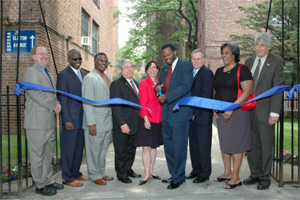Overview
In June 2006 the Clinton Hill Apartments in the Fort Greene neighborhood of Brooklyn, New York, completed the
largest installation of advanced microturbine cogenerating units serving a residential complex. Fueled by
clean-burning natural gas, the 13 units generate 600 kilowatts of electricity as well as hot water for 7 of the 12 buildings.
These dual-purpose units will reduce Clinton Hill's energy usage and costs by 40 percent and also enable the summer
shutdown of four nearly 60-year-old heavy residual oil burners used to produce hot water.
 | | Members of the community and project partners join Brooklyn Borough President Marty Markowitz, CAC Director Debbi Edelstein, Clinton Hill Apartments Board President John Dew, and NYSERDA President Peter Smith at the inauguration. |
The project is an important part of a coordinated effort to restore the moderate-income, minority Clinton Hill-Fort Greene
community to a bustling, economically vital neighborhood. The 1,221 units in the Clinton Hill Apartments were originally built
to house personnel for the old Brooklyn Navy Yard and became rental property when the base closed in 1966. In 1982 the apartments
were converted to cooperatives, and today 60 percent are owner-occupied, with most of the rest inhabited by rent-stabilized tenants.
As part of a refinancing plan, the complex is under-going major renovations, including a substantial electrical, heating, and
roofing upgrade.
Clinton Hill Apartments' board of directors was interested in the cogeneration technology for a number of reasons: it offers
clean, reliable energy; long-term cost control that helps maintain housing affordability; and improved air quality. The last was
especially important, as the NYC Department of Health has identified the Fort Greene area as having one of the highest rates of
asthma in the nation, at nearly 13 percent. Switching from the oil-fired boilers to clean cogeneration and reducing the use of
oil by up to 300,000 gallons a years significantly reduces both air toxics that contribute to respiratory illnesses and ozone
precursors that contribute to global warming.
Community support for the project was strong from the outset, as for eight years Clinton Hill Apartments had worked with
the Myrtle Avenue Revitalization Project to educate the community about quality-of-life issues. The project received endorsements
from elected officials, such as Brooklyn Borough President Marty Markowitz and State Senator Velmanette Montgomery, and from
community, educational, and environmental groups, including Pratt Area Community Council, New York Public Interest Research
Group, and Pratt Institute.
Funding
- Total Project Cost: $2,082,000
- CAC Funding: $465,000
- Co-Funding: $1,517,000 Clinton Hill, NYSERDA
- In-Kind Contributions: $100,000 KeySpan Energy, Energy Spectrum, Rand Engineering, Capstone Microturbine/UTC Power
Technology
The system generates heat and power using 13 Capstone/UTC natural gas-fired microturbines (seven 60kW and six 30Kw) certified by the California Air Resources Board. Each unit is roughly the size of a refrigerator. The project demonstrated the feasibility of the system for older, large-scale residential complexes and proved its cost-effectiveness, as the energy savings repays the capital costs in approximately four years.
Benefits
The more efficient system reduces overall energy use and costs by approximately 40 percent. By burning 200,000-300,000 fewer gallons of No. 6 oil each year, the system reduces emissions of nitrogen oxide by 5-8 tons, sulfur dioxide by up to 2 tons, and achieves meaningful reductions in particulate matter and air toxics.
|